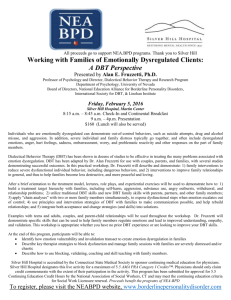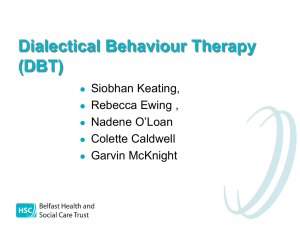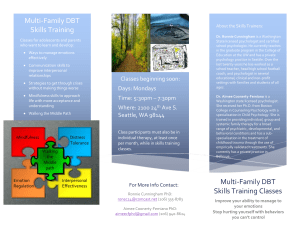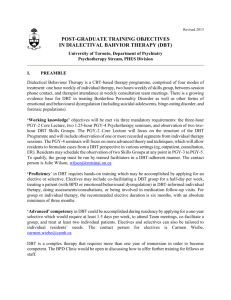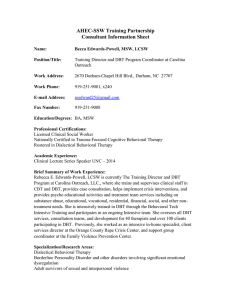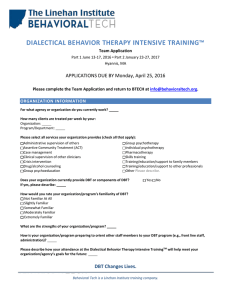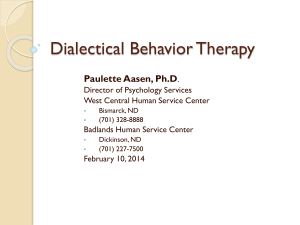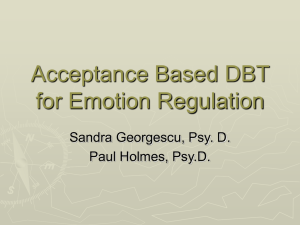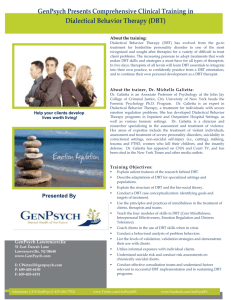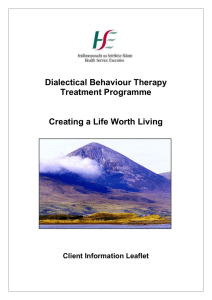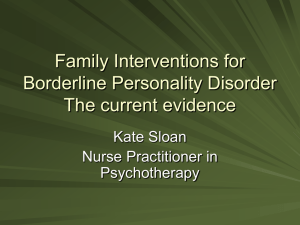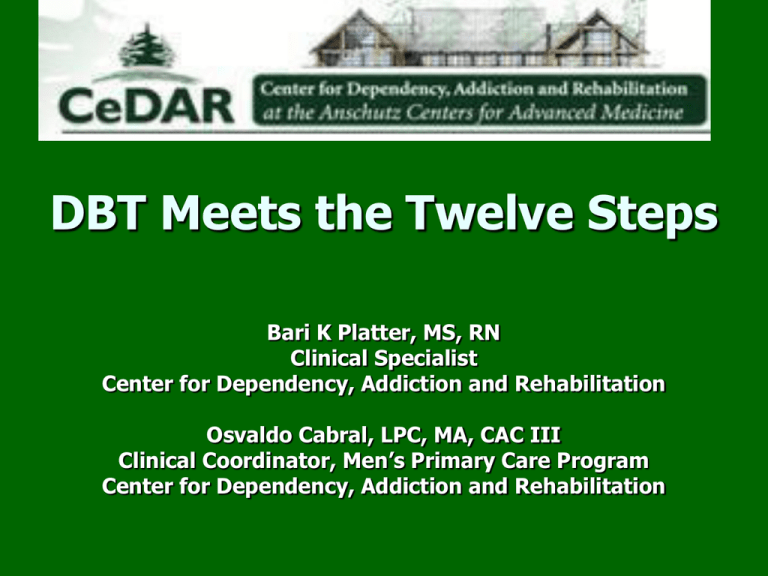
DBT Meets the Twelve Steps
Bari K Platter, MS, RN
Clinical Specialist
Center for Dependency, Addiction and Rehabilitation
Osvaldo Cabral, LPC, MA, CAC III
Clinical Coordinator, Men’s Primary Care Program
Center for Dependency, Addiction and Rehabilitation
Objectives
Review of EBP trends related to DBT and
Twelve Step Facilitation (TSF)
Discuss key concepts of DBT and TSF
Compare stages and targets of DBT with
Twelve Step philosophy
Review 4 modules from Integrating DBT
with the Twelve Steps workbook and
practice a sampling of the skills
Center for Dependency Addiction
and Rehabilitation (CeDAR)
Gender-specific 30 day inpatient
residential treatment
Residential extended care
Specializing in co-occurring diagnoses
Gambling and Sex Addiction
Professional’s Program
Family Program
Why use DBT?
Treatment for multi-disordered individuals with
persistent and severe problems
Extensive evidence based research: Combines
a scientific, objective approach with
compassion
Can be found throughout 12-step
literature and supports 12-step
philosophy
Key Concepts of DBT
Biosocial Theory (Emotion Dysregulation)
Validation
Dialectics
Dialectical Synthesis: The Middle
Path
A dialectical lifestyle
reflects balanced
behavioral patterns:
Balanced actions
Balanced emotions
Balanced cognition
Key Concepts of
Twelve Step Facilitation
Surrender
Self-Centeredness
Honesty, Open-mindedness and
Willingness
Alcoholics Anonymous &
Narcotics Anonymous
DBT Stages of Treatment
Pre-treatment
Commitment & Agreement
Stage 1
Severe behavioral dyscontrol
Outcome
Behavioral control
Stage 2
Quiet desperation
Outcome
Non-anguished emotional
experiencing
Stage 3
Problems in living
Outcome
Ordinary happiness &
unhappiness
Stage 4
Incompleteness
Outcome
Capacity for joy and freedom
Targets of DBT/12 Step Philosophy
Emotion
Dysregulation
Affective lability &
problems with anger
Internal
unmanageability
“Emotional volatility is
often one of the most
obvious ways in which we
can identify personal
unmanageability” (NA
workbook, p 4)
Interpersonal
Dysregulation
Chaotic relationships
& fears of
abandonment
“The alcoholic is
like a tornado,
roaring his way
through the lives of
others. Hearts are
broken. Sweet
relationships are
dead. Affections
have been
uprooted. Selfish
and inconsiderate
habits have kept
the home in
turmoil” (AA, p 82).
Self Dysregulation
Identity disturbances,
confused sense of self
Sense of emptiness
“We were
constantly
searching for the
answer. That
person place or
thing that would
make everything
alright” (NA, p 5).
Cognitive
Dysregulation
Dissociative
responses and/or
paranoid ideation
We were prisoners
of our own mind
and condemned by
our own guilt” NA,
p 7).
Behavioral
Dysregulation
Intentional self
harm and impulsive
behaviors
“Any life run on
self-will can hardly
be a success. On
that basis, we are
almost always in
collision with
somebody even
though our motives
are good” (AA,
p60).
Integrating Dialectical Behavior
Therapy and the Twelve Steps
Innovative individual and group programming
Facilitator Guide
Session Guides
Four Skills Modules
Twenty Group Sessions (60-90 minutes in length)
Participant Worksheets
Seventy-nine worksheets
CD for Worksheet duplication
Skills Group Structure
Introductions
Mindfulness warm up
exercise
Review assignment
from previous week
Teach/practice new
skills
Discuss new
assignment
Circle up
Workbook Modules
Mindfulness
Distress Tolerance
Interpersonal Effectiveness
Emotion Regulation
Mindfulness
States of Mind
Rational Mind
Wise
Mind
Emotional Mind
“You can’t think your way into right living,
but you can live your way into right
thinking”
States of Mind
Big Book, pg 26 __________ Mind
Big Book, pg 36 _________ Mind
NA, pg 87_________ Mind
Distress Tolerance
“Pain is inevitable, misery is optional”
Wise Mind ACCEPTS
Self Soothe the Five Senses
PROMISE
Radical Acceptance
Wise Mind ACCEPTS
Activities
Contributing
Counting Your Blessings
(Opposite) Emotions
Pushing Away
Thoughts
Sensations
Self-Soothe with the Five Senses
Explore patient’s experience with self soothing
Brainstorm self soothing approaches used in the
past
Introduce new self soothing activities
Aromatherapy
Hot showers and baths
Yoga/exercise
Walking meditation
“For some reason, despite the resources
available to me growing up, I developed
into an adult woman terrified of the world
around me. I was extremely insecure,
though I was careful to hide this fact. I
was unable to handle and understand my
emotions; I always felt as if everyone else
knew what was going on and what they
were supposed to be doing. … When I
was drinking, I was okay. I understood.
Everything made sense. I could dance,
talk, and enjoy being in my own skin”
(AAWS, p 319-320).
PROMISE
Prayer
Relaxation
One Step at a Time
Meaning
Imagery
Seek Guidance
Encouragement
Accepting Reality
Radical Acceptance
Turning the mind
Willingness vs Willfulness
Interpersonal Effectiveness
Distortions, Absolutes & Stories
Mutual Purpose, Mutual Respect
SHARE and DEAR MAN
SHARE
Situation- what is the situation?
Honest expression of feelings
Admit when you’re wrong
Remember past performance & present
behavior
Emphasize spiritual principles
Emotion Regulation
(smooth) SAILING
SERENITY
(smooth) SAILING
Stop & recognize your emotions
Acknowledge its affect
Improve with spiritual principles
Let go
Identify successes
No needless judging
Gratitude
SERENITY
Slow thoughts
Effective behavior
Relax and breathe
(stay grounded in your) Environment
Notice others
Imagine success
Tolerate your traits
You can do this!
Summary/Comments/ Q & A

